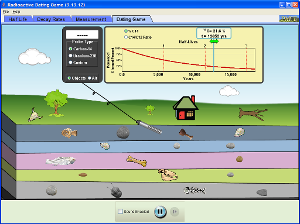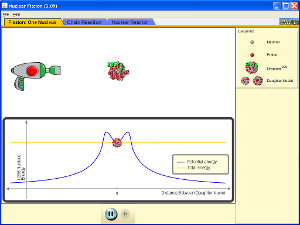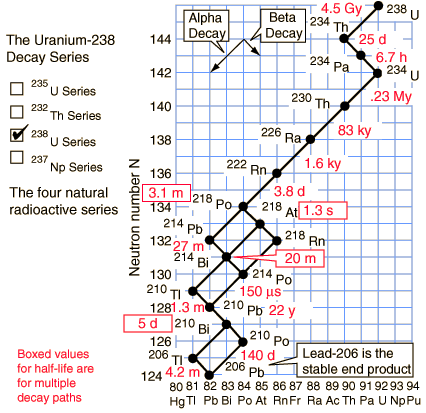Tuesday, May 28, 2013
Friday, May 24, 2013
The Last Assignment
Last week, we had a lot of unanswered questions:
- What is a muon
- What can we do with the new elementary particles
- What is a Higgs Boson
- What's a neutrino
- Why did the Tevatron shut down
- What's a fermion
Scientists ask a lot of these questions as well. And that's why CERN and Fermilab exist.
Your last assignment involves watching two videos
http://www.youtube.com/user/CERNTV (Watch the introduction video on the CERNTV channel)
http://www.youtube.com/watch?v=RIg1Vh7uPyw (the Higgs particle on the FERMILAB channel)
and then writing a personal reflection on how this new physics fits into the world of forces, motion (velocity and acceleration), mass, and energy studied in this class. The easiest way to do this is to write a paragraph or two about each subject.
Tuesday, May 21, 2013
Radioactivity
Part 1: Answer the problems found below. For each one you can use a hand-drawn chart like this one, or the table that is attached, but you MUST show your logic for each project. Just writing down the answer will not get you credit.
1) The half life of iodine-131 is 8.040 days. What percentage of an iodine-131 sample will remain after 40.2 days?
2) The half-life of thorium-227 is 18.72 days How many days are required for three-fourths of a given amount to decay?
3) If you start with 5.32 x 109 atoms of Cs-137, how much time will pass before the amount remaining is 5.20 x 106? The half-life of Cs-137 is 30.17 years.
4) The half-life of the radioactive isotope phosphorus-32 is 14.3 days. How long until a sample loses 99% of its radioactivity?
5) U-238 has a half-life of 4.46 x 109 years. How much U-238 should be present in a sample 2.5 x 109 years old, if 2.00 grams was present initially? (Hand this in individually)
Part 2: Create a video public service announcement that tells the class about one of the following. I would prefer you spread out across all the topics, rather than several people doing the same thing.
1) The half life of iodine-131 is 8.040 days. What percentage of an iodine-131 sample will remain after 40.2 days?
2) The half-life of thorium-227 is 18.72 days How many days are required for three-fourths of a given amount to decay?
3) If you start with 5.32 x 109 atoms of Cs-137, how much time will pass before the amount remaining is 5.20 x 106? The half-life of Cs-137 is 30.17 years.
4) The half-life of the radioactive isotope phosphorus-32 is 14.3 days. How long until a sample loses 99% of its radioactivity?
5) U-238 has a half-life of 4.46 x 109 years. How much U-238 should be present in a sample 2.5 x 109 years old, if 2.00 grams was present initially? (Hand this in individually)
Part 2: Create a video public service announcement that tells the class about one of the following. I would prefer you spread out across all the topics, rather than several people doing the same thing.
- Irradiation of spices using cobalt-60
- Radon is a big problem in Iowa
- Cs-133 atomic clock uses
- Iodine-131 uses
- Americium-241 for gauging plastic
- Americium-241 smoke detectors
- CT vs. PETscans using C-11, N-13, or O-15
- Uses of Technicium-99m
- Fresh food irradiation using cobalt-60 to kill ecoli or other bacteria.
The following information must be present in your video clip:
a. What type of decay is going on?
b. What is the half-life of the object, and how long will it take for 99% to disappear
c. How can we protect humans from this type of isotope when we don't want to be exposed to it?
d. How are force or momentum used in this process?
e. How valuable is this process?
f. How is the use of this radioactive tool comparable to a non-nuclear option. Pick two similarities and two differences.
g. Why is radioactivity all around us? And what's the difference between radioactivity and antimatter.
Upload your video to a youtube account and share with me.
Grading Rubric
Content correctness: 10 points
Entertainment value: 10 points
Use of media to enhance presentation: 5 points
Involvement by all members of group: 5 points
Title or Credits, as appropriate: 5 points
Monday, May 20, 2013
Radioactive Dating
Alpha Decay follow-up applet
Beta Decay follow-up applet
1. Your goal is to date 10 items on the simulation below. Tell me how you found each one, making a table
|ITEM | ISOTOPE USED | ESTIMATED AGE |

Run the simulation. Before the gun is fired, is the material stable, or does it seem likely to radioactively decay?
When you operate the gun, what type of particle does it fire?
If the gun fires and “hits” the nucleus, what happens?
Switch the tab to “chain reaction” and add some uranium-238. The atom used in the previous tab was uranium-235. Is uranium-238 “fissionable”? How does firing the gun on a uranium-238 atom change it? (Note you can aim the gun.)
Chain reaction:
Switch to the tab “Chain Reaction”.
Reset the sim (using the button) and add lots of fissionable uranium-235. What happens and why?
Normal levels of the uranium-235 isotope are about 0.72%, with the majority being uranium-238. Round the level up to 1% (in the favor of uranium-238), to one atom of uranium-235 and 99 atoms of uranium 238. Use the simulation to discover if naturally-derived uranium can start a chain reaction (and therefore be useful in either nuclear weapons or nuclear power plants): Is naturally derived uranium able to start a chain reaction, or must the sample be “enriched”?
Use the simulation to find a minimum ratio of uranium-235 to uranium-238 (keep your total of atoms always at 100); what is the smallest percentage that still starts a chain reaction?
How does the above compare to “weapons-grade” enriched uranium (about 80-85%)?
(these questions mirrored from here)

Beta Decay follow-up applet
1. Your goal is to date 10 items on the simulation below. Tell me how you found each one, making a table
|ITEM | ISOTOPE USED | ESTIMATED AGE |

Run the simulation. Before the gun is fired, is the material stable, or does it seem likely to radioactively decay?
When you operate the gun, what type of particle does it fire?
If the gun fires and “hits” the nucleus, what happens?
Switch the tab to “chain reaction” and add some uranium-238. The atom used in the previous tab was uranium-235. Is uranium-238 “fissionable”? How does firing the gun on a uranium-238 atom change it? (Note you can aim the gun.)
Chain reaction:
Switch to the tab “Chain Reaction”.
Reset the sim (using the button) and add lots of fissionable uranium-235. What happens and why?
Normal levels of the uranium-235 isotope are about 0.72%, with the majority being uranium-238. Round the level up to 1% (in the favor of uranium-238), to one atom of uranium-235 and 99 atoms of uranium 238. Use the simulation to discover if naturally-derived uranium can start a chain reaction (and therefore be useful in either nuclear weapons or nuclear power plants): Is naturally derived uranium able to start a chain reaction, or must the sample be “enriched”?
Use the simulation to find a minimum ratio of uranium-235 to uranium-238 (keep your total of atoms always at 100); what is the smallest percentage that still starts a chain reaction?
How does the above compare to “weapons-grade” enriched uranium (about 80-85%)?
(these questions mirrored from here)

| Click to Run |
| Click to Run |
Friday, May 17, 2013
U-238 Decay series
 |
| http://radonmd.com/sitebuildercontent/sitebuilderpictures/Radonchart100diagram.gif
Step 1: Create a half-life graph for an isotope with a half-life of
using the data matrix from yesterday. You can get free graph paper, if you need it, from http://www.printfreegraphpaper.com/
Step 2: Tell me the significance of this photo.
Step 3: Tell me why radon is a problem. Include a parent that makes radon and a daughter product. (Hint: consider states of matter--solid, liquid, gas)
Step 4: Pick one of the isotopes on this graphic and tell me what it is used for in society.
Step 5: Explain how probability influences the multiple pathways found on the bottom of this chart.
|
Wednesday, May 15, 2013
Unit 1 Particle Physics
We start today with the frontier of physics. Those ideas that are driving the next generation of engineers, cosmologists and scientists to ask new questions about how the universe works.
Let's start with a question generator:
http://www.popsci.com/science/article/2013-05/scientists-will-move-50-foot-ring-3200-miles-summer-physics-sake
http://www.symmetrymagazine.org/article/january-2013/bosons
http://www.symmetrymagazine.org/article/december-2012/decay-channel
http://www.symmetrymagazine.org/article/september-2012/explain-it-in-60-seconds-klystron
http://www.symmetrymagazine.org/article/december-2009/explain-it-in-60-seconds-scintillators
Now, are there answers we can find here?
http://serc.carleton.edu/quantskills/methods/quantlit/RadDecay.html
1/2 page summary of today on back of graph. Hand in.
Let's start with a question generator:
http://www.popsci.com/science/article/2013-05/scientists-will-move-50-foot-ring-3200-miles-summer-physics-sake
http://www.symmetrymagazine.org/article/january-2013/bosons
http://www.symmetrymagazine.org/article/december-2012/decay-channel
http://www.symmetrymagazine.org/article/september-2012/explain-it-in-60-seconds-klystron
http://www.symmetrymagazine.org/article/december-2009/explain-it-in-60-seconds-scintillators
Now, are there answers we can find here?
http://serc.carleton.edu/quantskills/methods/quantlit/RadDecay.html
1/2 page summary of today on back of graph. Hand in.
Friday, May 10, 2013
ITSISU Friday
Projectile Problem Review (on board)
ITSISU Activity (groups)
ITSISU Post-Test (individual)
=================
For Monday, bring in a video of a projectile to analyze using logger pro. Each person will need to analyze their own. If you wish, you may take individual videos as needed and place on a laptop (but be sure to label your laptop today if you choose to do this)
ITSISU Activity (groups)
ITSISU Post-Test (individual)
=================
For Monday, bring in a video of a projectile to analyze using logger pro. Each person will need to analyze their own. If you wish, you may take individual videos as needed and place on a laptop (but be sure to label your laptop today if you choose to do this)
Friday, May 3, 2013
Starting Projectile Motion
Go to the ITSI-SU link
In the top left of the page, choose Sign-Up. Your passcode is the word: springscale
Take the pretest and complete the math activity. To do this, you will need to take turns. EVERYONE does this individually. It requires a laptop with Java, so you have until Monday to complete this task. It is worth a fair number of points, so do not forget.
=========================
Video Analysis: Motion on a diving board. You will need to capture video from a side viewpoint.
=========================
All materials for the pool momentum unit are due on Monday.
In the top left of the page, choose Sign-Up. Your passcode is the word: springscale
Take the pretest and complete the math activity. To do this, you will need to take turns. EVERYONE does this individually. It requires a laptop with Java, so you have until Monday to complete this task. It is worth a fair number of points, so do not forget.
=========================
Video Analysis: Motion on a diving board. You will need to capture video from a side viewpoint.
=========================
All materials for the pool momentum unit are due on Monday.
Thursday, May 2, 2013
Final Artifacts
Make a folder in Google Drive and put in the following for your final portfolio. Share the folder with me.
1. Hand in a scaled model of your pool table that includes top and side views. This may be done using graph paper, sketch-up, or a CAD program, but the final product must be digitized.
2. Hand in the data analysis for the two inelastic collisions that includes the dot diagrams on the video and your calculations from Monday. Talk with me before you do this.
3. Hand in the analysis for the bumper collision of the ball, showing me a) the momentum before the collision, b)the momentum after the coll ision, c) the net time the bumper and the ball were in contact, and d) calculations of the change in momentum and the impulse Force. This is most easily done using paper and pencil and then taking a picture of the finished project.
4. A picture of your group and your pool table.
======================
Evaluate a pool table that is not your own from a different table cluster.
======================
Finish the Guilty Until Proven Innocent Activity
1. Hand in a scaled model of your pool table that includes top and side views. This may be done using graph paper, sketch-up, or a CAD program, but the final product must be digitized.
2. Hand in the data analysis for the two inelastic collisions that includes the dot diagrams on the video and your calculations from Monday. Talk with me before you do this.
3. Hand in the analysis for the bumper collision of the ball, showing me a) the momentum before the collision, b)the momentum after the coll ision, c) the net time the bumper and the ball were in contact, and d) calculations of the change in momentum and the impulse Force. This is most easily done using paper and pencil and then taking a picture of the finished project.
4. A picture of your group and your pool table.
======================
Evaluate a pool table that is not your own from a different table cluster.
======================
Finish the Guilty Until Proven Innocent Activity
Subscribe to:
Posts (Atom)

